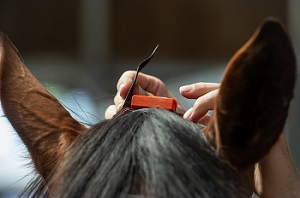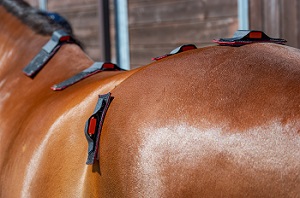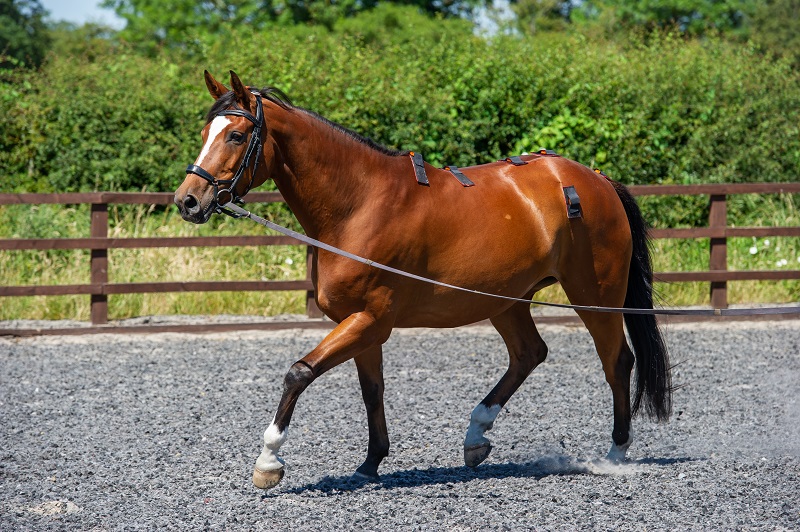Objective Gait Analysis for Poor Performance
Clinical Connections – Summer 2021
Andy Fiske-Jackson, Deputy Head of RVC Equine and Senior Lecturer in Equine Surgery
Horses are frequently presented to the RVC Equine Referral Hospital for investigation of poor performance. Following acquisition of a thorough history, the horse is examined. Usually this will start with a lameness investigation.

The main advantage of using OGA is the potential to remove bias from clinical decision-making. At the RVC we are pursuing its use in measuring back movement and seeking to correlate this with the presence of back pain. Inertial measurement units are placed on the horse (Figure 1 and 2) and the horse is assessed both unridden (Figure 3) and under saddle.
Lameness ‘threshold values’ that exist with OGA were derived by comparing OGA measurements with veterinary expert assessments following induced lameness. Whilst these thresholds should not be interpreted as an absolute cut off point, if an owner reports a drop in performance and the values lie outside the thresholds, it is sensible to explore the reason for the asymmetry to establish whether it is linked to the loss of performance; it certainly demonstrates the limb which is producing less force than the others.

Asymmetry can be so mild that it can be difficult to detect. If this is the case, how can we ensure it is clinically relevant? It is obvious that its relevance should be assessed in the context of the horse’s breed, use, age, history and what the rider reports. As an example, a dressage rider may notice reduced hindlimb push off during a canter pirouette in one direction compared to the other well before it become visually evident when the horse is trotted in hand. If OGA can detect a subtle lameness, undetectable to the human eye, and those values return to the normal accepted range following nerve or joint blocks, and the rider reports an improvement, this increases the security of the diagnosis. OGA gives the user confidence to embark on a lameness work-up in this situation and adds objectivity to the post-block assessment.
There has been debate about OGA focusing on the initial assessment – whether the user should rely solely on it to detect pain-induced lameness – certainly we should not. However, once lameness has been detected, and a lameness work up using nerve and joint blocks has started, improvements can be confirmed with OGA. Whilst nerve blocks may completely resolve lameness when the area of pain is desensitised, joint blocks can be less conclusive. The response to stifle blocks in particular can be modest even if demonstrable pathology is ultimately evident on either diagnostic imaging or arthroscopy. Improvement well below 50% can be expected in such cases and OGA can add reassurance in confirming a subjective perception of improvement.
Like all technology, its value is only as good as its interpretation. Veterinarians are faced with this scenario every day (e.g. blood results, ultrasound scans, radiographs etc.) and, of course, experience is invaluable.

Wireless ultrasound
With the support of the Animal Care Trust, the RVC Equine Referral Hospital recently acquired wireless ultrasound probes. The probes emit a Wifi signal that wirelessly connects with any smartphone, tablet or Windows operating system laptop, meaning they can be used in remote areas without internet connection. These probes are light and easy to handle and the image resolution is excellent. The absence of wires makes them safer to use around the limbs of horses and also allows the screen to be placed in a safe location. It also lends itself well to intraoperative scanning facilitating maintenance of sterility.
